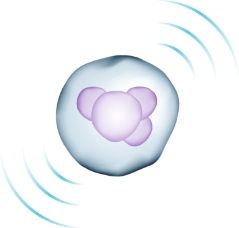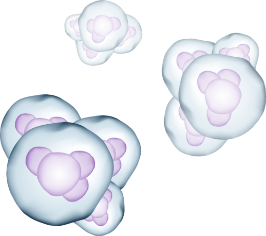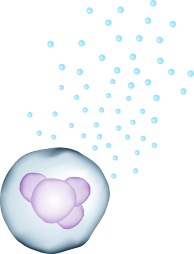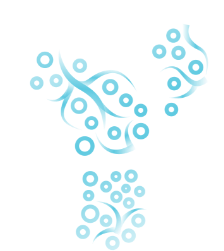AN URGENT NEED EXISTS FOR BROADER DISEASE CONTROL IN MYELOFIBROSIS1
MF
Myelofibrosis (MF) is a rare type of blood cancer characterized by a dysregulated bone marrow microenvironment, resulting in progressive fibrosis and impaired hematopoiesis2‑4
The aggressive and heterogeneous nature of many hematologic malignancies complicates treatment and can result in poor survival.5,6


Explore the unmet need in myelofibrosis with Dr Andrew Kuykendall
So, oftentimes, patients with myelofibrosis present with enlarged spleens or these things we call constitutional symptoms.
So, fever, chills, night sweats, bone pain, weight loss.
These are inflammatory symptoms, and both the spleen and the symptoms are critically tied.
Oftentimes, patients have both of these to some extent, and these associate with a poor quality of life and decreased overall survival.
The other concern that we have is ultimately patients may deal with other changes in their blood counts, and so they may notice that their white blood cell count is elevated with hemoglobin being low.
So, if you have moderate to marked fibrosis, patients have a much different prognosis than if they have minimal to mild fibrosis.
Additionally, the more scar tissue in fibrosis you get actually probably influences the ability to have normal erythropoiesis.
And so, oftentimes this fibrosis level is linked to the degree of anemia, the need for transfusions.
So, when you think about myelofibrosis, I think you can consider this and really focus in on 4 different hallmarks of the disease: splenomegaly or spleen enlargement, constitutional symptoms, anemia, and bone marrow fibrosis.
Certainly, the first 3 when we talk about symptoms, spleen, and anemia, these are often reasons that the patients present to the clinic.
And then bone marrow fibrosis is something that’s inherently linked to the disease.
Historically, we’ve had JAK inhibitors, which have been approved for the indication of myelofibrosis, and they’re very effective at attacking the splenomegaly and the constitutional symptoms.
I think that one thing we know is that patients who receive JAK inhibitor therapy don’t typically do so for an extended period of time.
Half of patients will be off of a JAK inhibitor at about 3 years. This is what long-term follow-up with some of these critical studies has shown us.
And we know that outcomes after JAK inhibitor therapy discontinuation are quite poor.
So, we need to be thinking about how do we extend the durability of our responses with these agents and get patients to stay on therapy with controllable disease for a longer period of time?
So, as we mentioned, bone marrow fibrosis is a hallmark of the disease. I think that this is diagnostically linked to myelofibrosis.
It’s something we know we have to look at when we’re looking at clinical trials if we want to achieve disease modification.
As you get more fibrosis, more scar tissue in the marrow, it becomes more of an inhospitable environment to have normal hematopoiesis, and that’s where we start to see a link with more anemia, more difficulty in making red blood cells.
I think if we truly think we’re getting rid of the disease we would expect bone marrow fibrosis to change.
What JAK inhibitors are able to do is reduce spleen volume and improve symptoms.
And they do this pretty much for all patients; however, there are some limitations to JAK inhibitors.
I would say first and foremost these do not get rid of the underlying disease, so when we look at the bone marrow oftentimes we still see disease that’s there.
We still see a hypercellular marrow, megakaryocytic atypia, and the mutations that drive the disease are usually still present, right? They may shift in how often they're there, but they're usually still present.
So, we’re not having a lot of disease response and, unfortunately, we’re not talking about complete or partial responses when we use JAK inhibitors.
We’re talking about clinical improvements.
Overall, the limitations to me are lack of a disease-modifying effect, the fact that it actually worsens other cytopenias and the inability to give it to some patients that have preexisting cytopenias, and overall a lack of duration or durability as far as treatment goes.
And so I think those are the things we are looking to improve when we’re trying to treat our myelofibrosis patients in a better way.
References:
- Al-Ali HK, Griesshammer M, le Coutre P, et al. Safety and efficacy of ruxolitinib in an open-label, multicenter, single-arm phase 3b expanded-access study in patients with myelofibrosis: a snapshot of 1144 patients in the JUMP trial. Haematologica. 2016;101(9):1065-1073. doi:10.3324/haematol.2016.143677
- Mesa R, Su Y, Woolfson A, et al. Development of a symptom assessment in patients with myelofibrosis: qualitative study findings. Health Qual Life Outcomes. 2019;17(1):61. doi:10.1186/s12955-019-1121-1
- Guglielmelli P, Rotunno G, Pacilli A, et al. Prognostic impact of bone marrow fibrosis in primary myelofibrosis. A study of the AGIMM group on 490 patients. Am J Hematol. 2016;91(9):918-922. doi:10.1002/ajh.24442
- Lacout C, Pisani DF, Tulliez M, et al. JAK2V617F expression in murine hematopoietic cells leads to MPD mimicking human PV with secondary myelofibrosis. Blood. 2006;108(5):1652-1660. doi:10.1182/blood-2006-02-002030
- Takenaka K, Shimoda K, Akashi K. Recent advances in the diagnosis and management of primary myelofibrosis. Korean J Intern Med. 2018;33:679-690. doi:/10.3904/kjim.2018.033
- NCCN Clinical Practice Guidelines in Oncology (NCCN Guidelines®) for Myeloproliferative Neoplasms V.3.2023. © National Comprehensive Cancer Network, Inc. 2023. All rights reserved. Accessed October 1, 2023. To view the most recent and complete version of the guideline, go online to NCCN.org
- Harrison CN, Schaap N, Mesa RA. Management of myelofibrosis after ruxolitinib failure. Ann Hematol. 2020;99(6):1177-1191. doi:10.1007/s00277-020-04002-9
- Scherber R, Mesa R. Management of challenging myelofibrosis after JAK inhibitor failure and/or progression. Blood Rev. 2020;42:100716. doi:10.1016/j.blre.2020.100716
- Pemmaraju N, Verstovsek S, Mesa R, et al. Defining disease modification in myelofibrosis in the era of targeted therapy. Cancer. 2022;128:2420-2432. doi:10.1002/cncr.34205
- Wilkins BS, Radia D, Woodley C, Farhi SE, Keohane C, Harrison CN. Resolution of bone marrow fibrosis in a patient receiving JAK1/JAK2 inhibitor treatment with ruxolitinib. Haematologica. 2013;98(12):1872-1876. doi:10.3324/haematol.2013.095109
- Vachhani P, Verstovsek S, Bose P. Disease modification in myelofibrosis: an elusive goal? J Clin Oncol. 2022;40(11):1147-1154. doi:10.1200/JCO.21.02246
- Kleppe M, Koche R, Zou L, et al. Dual targeting of oncogenic activation and inflammatory signaling increases therapeutic efficacy in myeloproliferative neoplasms. Cancer Cell. 2018;33(1):29-43. doi:10.1016/j.ccell.2017.11.009
- Verstovsek S, Mesa RA, Gotlib J, et al. A double-blind, placebo-controlled trial of ruxolitinib for myelofibrosis. N Engl J Med. 2012;366(9):799-807. doi:10.1056/NEJMoa1110557
- Jiang Q, Jamieson C. BET'ing on dual JAK/BET inhibition as a therapeutic strategy for myeloproliferative neoplasms. Cancer Cell. 2018;33(1):3-5. doi:10.1016/j.ccell.2017.12.007
- Ross D, Babon J, Tvorogov D, et al. Persistence of myelofibrosis treated with ruxolitinib: biology and clinical implications. Haematologica. 2011;106(5):1244-1253. doi:10.3324/haematol.2020.262691
- Copher R, Kee A, Gerds A. Treatment patterns, health care resource utilization, and cost in patients with myelofibrosis in the United States. Oncologist. 2022;27(3):228-235. doi:10.1093/oncolo/oyab058
- Naymagon L, Mascarenhas J. Myelofibrosis-related anemia: current and emerging therapeutic strategies. Hemasphere. 2017;1(1):e1. doi:10.1097/HS9.0000000000000001
- Bose P, Verstovsek S. JAK inhibition for the treatment of myelofibrosis: limitations and future perspectives. Hemasphere. 2020;4:4(e424). doi:10.1097/HS9.0000000000000424
- Mascarenhas J, Gerds A, Verstovsek S. Paradigm shift: combination BET and JAK inhibition in myelofibrosis. Leukemia. 2021;35(12):3361-3363. doi:10.1038/s41375-021-01405-z
- Hilton J, Cristea M, Postel-Vinay S, et al. BMS-986158, a small molecule inhibitor of the bromodomain and extraterminal domain proteins, in patients with selected advanced solid tumors: results from phase 1/2a trial. Cancers. 2022;14:4079. doi:10.3390/cancers14174079
At diagnosis, approximately 90% of patients with MF have intermediate- or high-risk disease, which are both associated with more advanced disease features7
The median overall survival
for patients with intermediate-1, intermediate-2, or high-risk myelofibrosis is
~6.5, ~2.9, and ~1.3 years, respectively.7
Patients with myelofibrosis often present clinically with 4 main hallmarks that are associated with poor quality of life and short survival8,9:
Significant symptom burden, including fatigue, fever, and bone pain
Several studies have shown a correlation between inflammation and perceived symptoms of MPNs such as MF. Elevated levels of inflammatory cytokines have been linked to cancer-related fatigue, fever, and night sweats.10
Anemia, arising due to changes in the bone marrow microenvironment
Anemia in MF is multifactorial in nature and complex to address. Impaired hematopoiesis can lead to anemia, which in turn can be linked to other symptoms.11,12
Splenomegaly due to splenic extramedullary hematopoiesis (EMH)
Splenomegaly can cause abdominal pain and early satiety with the depth and durability of spleen response to the current standard of treatment correlating with overall survival.13,14
Impairment of the bone marrow microenvironment, including bone marrow fibrosis
The proliferation of clustering atypical megakaryocytes and inflammatory cytokines within the bone marrow is also a key indicator of MF and contributes significantly to disease progression.12,15-17
Bone marrow fibrosis is a key indicator of disease progression, with higher-grade bone marrow fibrosis correlating to4:
- Low hemoglobin counts
- Increased spleen volume
- Higher risk assessment scores (eg, IPSS/DIPSS)
Higher-grade (>1) bone marrow fibrosis has been linked to more advanced disease, severe anemia, and reduced survival.4,20,21
An unmet need exists for an agent that can support deeper and more
durable responses in combination with JAK inhibition.11,18,19







